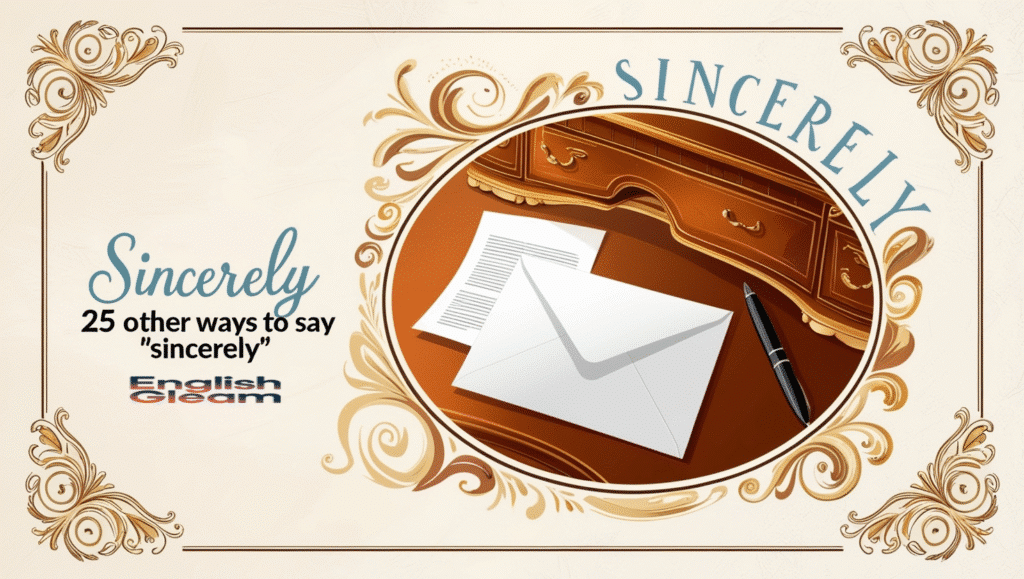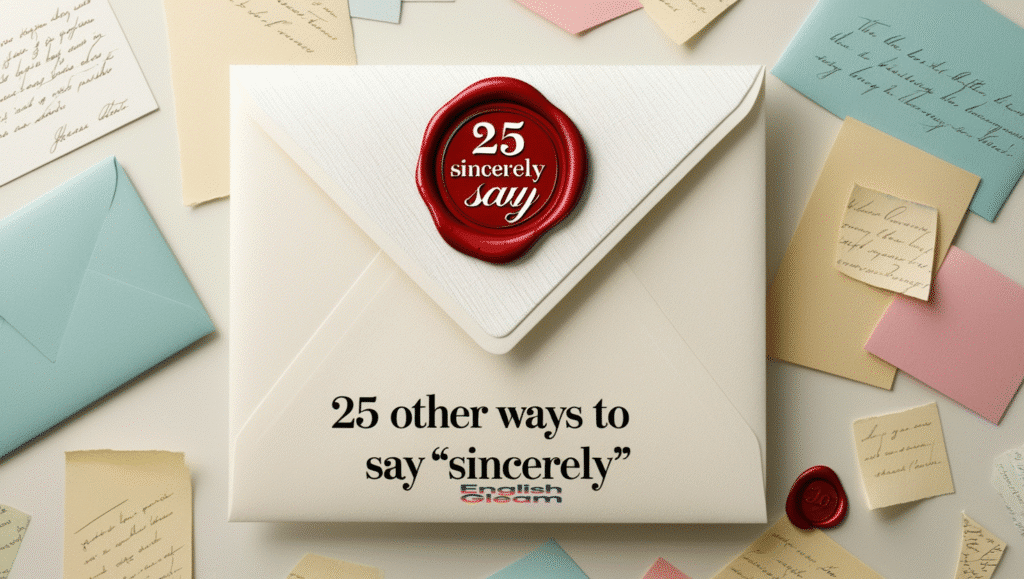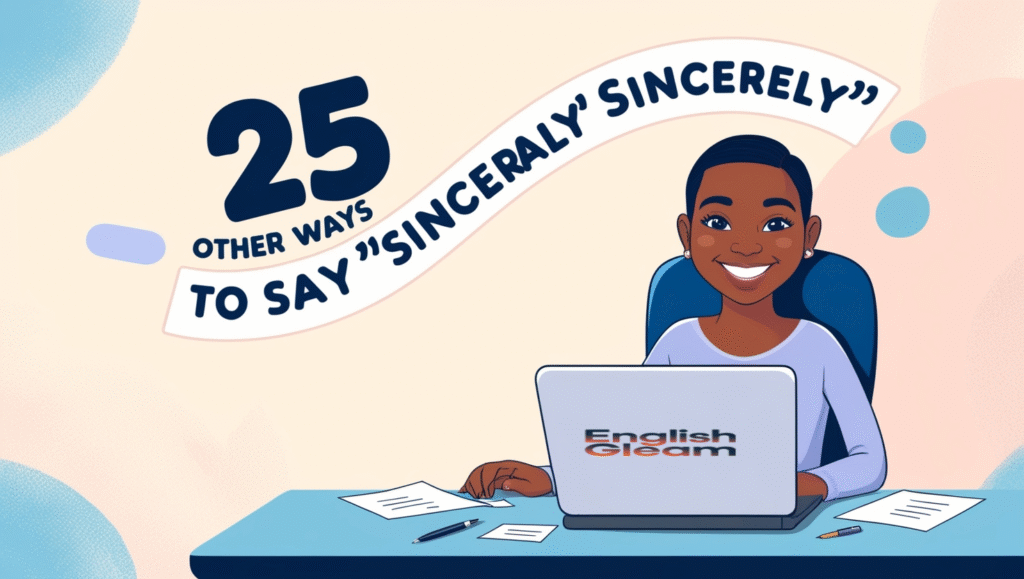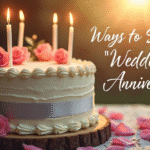“Sincerely” is a word we use to end letters or emails in a polite way. It shows honesty, respect, and a kind tone. But there are many other ways to say it.
Tired of using “Sincerely” again and again? Want your emails to feel fresh and friendly? This list will help you say goodbye with style.
Some closings are formal, others more friendly. You can choose one based on your tone and message. Each phrase also includes a simple example.
Why Choose a Different Professional Closing? oost connection. A carefully chosen email closing shows you thought about your reader.
- Avoid monotony – If you always use “sincerely,” your emails can sound robotic.
- Match tone – Formal memo? Friendly thank‑you note? Your sign‑off should reflect that.
- Show character – The right polite sign‑off lets your personality shine professionally.
How to Pick the Right Sign‑Off
Use this simple table to guide your choice:
| Tone Needed | Formality Level | Suggested Sign‑Offs |
|---|---|---|
| Ultra‑formal | Highest | Respectfully, Yours Faithfully, With Sincerity |
| Business‑professional | Medium | Best Regards, Kind Regards, With Appreciation |
| Warm‑but‑professional | Medium‑Low | Warm Regards, All the Best, With Best Wishes |
| Informal‑friendly | Low | Cheers, Take Care, Stay Well |
| Gratitude‑focused | Any | With Gratitude, Many Thanks, Appreciatively |
| Encouraging/Supportive | Any | To Your Continued Success, Be Well, Until Next Time |
Ultra‑Formal & Respectful
1. Respectfully
- Tone: Formal, deferential
- Use when: Addressing executives, judges, or public officials
- Example: Thank you for your time and attention to this matter.
Respectfully,
Your Name
2. Yours Faithfully
- Tone: Traditional, UK formal
- Use when: You don’t know the recipient’s name
- Example: Dear Sir/Madam,
I enclose my application for the position.
Yours faithfully,
Your Name
3. With Sincerity
- Tone: Emphasizing honesty and truthfulness
- Use when: You want to underscore authenticity
- Example: I hope this clears up any confusion.
With sincerity,
Your Name
Business‑Professional
4. Best Regards
- Tone: Neutral‑professional
- Use when: Regular office emails, follow‑ups
- Example: Thank you for the update.
Best regards,
Your Name
5. Kind Regards
- Tone: Slightly warmer
- Use when: You’ve worked together before
- Example: I appreciate your thoughtful edits.
Kind regards,
Your Name
6. With Appreciation
- Tone: Grateful yet professional
- Example: Thanks for reviewing the draft.
With appreciation,
Your Name
7. With Best Wishes
- Tone: Friendly and polite
- Example: Good luck with the presentation.
With best wishes,
Your Name
you also might like : 25 Other Ways to Say “Sorry to Bother You”
Warm & Personable
8. Warm Regards
- Tone: Warm, welcoming
- Example: I enjoyed our discussion today.
Warm regards,
Your Name
9. Warmest Regards
- Tone: Extra warmth
- Example: We had a great session—thanks!
Warmest regards,
Your Name
10. All the Best
- Tone: Casual yet supportive
- Example: Best of luck with the launch.
All the best,
Your Name

Gratitude‑Centric
11. With Gratitude
- Tone: Sincere and thankful
- Example: Your mentorship means a lot.
With gratitude,
Your Name
12. Many Thanks
- Tone: Warmly appreciative
- Example: Thanks for all the help this week.
Many thanks,
Your Name
13. Appreciatively
- Tone: Genuine thanks
- Example: I appreciate your feedback on this document.
Appreciatively,
Your Name
14. Thanks Again
- Tone: Reinforcing gratitude
- Example: I truly appreciate the extra mile you went.
Thanks again,
Your Name
Casual & Friendly
15. Cheers
- Tone: Light and friendly
- Use for: Coworkers, creative teams
- Example: Great job on the event!
Cheers,
Your Name
16. Take Care
- Tone: Caring and informal
- Example: Looking forward to catching up soon.
Take care,
Your Name
17. Stay Well
- Tone: Gentle concern
- Example: Stay safe as you travel.
Stay well,
Your Name
18. Be Well
- Tone: Similar to above
- Example: Take some time to rest.
Be well,
Your Name

Motivating & Supportive
19. To Your Continued Success
- Tone: Encouraging and optimistic
- Example: Wishing you success in the launch.
To your continued success,
Your Name
20. Until Next Time
- Tone: Anticipatory
- Example: Let’s talk again soon.
Until next time,
Your Name
21. Looking Forward
- Tone: Friendly expectancy
- Example: I can’t wait to collaborate again.
Looking forward,
Your Name
Cordial & Community‑Focused
22. Cordially
- Tone: Polite and timeless
- Example: Thank you for your patience.
Cordially,
Your Name
23. Yours Truly
- Tone: Classic and honest
- Example: It was a pleasure working with you.
Yours truly,
Your Name
24. Yours in Service
- Tone: Helpful and team‑oriented
- Example: How can I assist further?
Yours in service,
Your Name
25. Faithfully Yours
- Tone: Deeply respectful
- Example: Thank you for your guidance today.
Faithfully yours,
Your Name
Quick Comparison Table
| Sign‑Off | Tone | Best Use |
|---|---|---|
| Respectfully | Ultra‑formal | Correspondence with senior figures |
| Best Regards | Professional | Everyday office emails |
| Warm Regards | Friendly | Colleagues you like and respect |
| With Gratitude | Appreciative | After favors or support |
| Cheers | Casual | Creative, friendly teamwork |
| Take Care / Be Well | Caring | Informal, supportive email |
| To Your Continued Success | Motivational | Congratulatory or celebratory contexts |
| Yours in Service | Service‑mind | Non-profit, client‑focused, or support roles |
Pro Tips to Pick the Perfect Sign‑Off
- Mirror the tone: Keep consistency from greeting to closing.
- Know your reader: Match their expectations—colleague? manager? stranger?
- Check formality level: Formal letter demands formal sign-off.
- Mind cultural nuance: British vs US sign-off norms may differ.
- Swap it up: Avoid monotony—small changes keep messages fresh.
Best Practices for Final Lines & Sign‑Offs
- End with value – “Please let me know if there’s anything else.”
- Add a personal touch – Reference a shared event or interest.
- Don’t overdo emotion – A “Warm regards” works; a novel-length close doesn’t.
- Match signature format – Formal letter? Typed name. Soft email? A simple sign‑off.
- Proofread! – It’s easy to delete a phrase and forget to update your closing.
FAQ
Q1: What’s the most formal sign‑off for a business letter?
A: Use Respectfully, Yours Faithfully, or With Sincerity. Those show high respect in formal correspondence.
Q2: Can I use “Cheers” in a work email?
A: Sure—but only with colleagues you know well or in relaxed industries. It’s not ideal for executives or brand-new contacts.
Q3: Should I always vary my email closing?
A: Not always. A consistent sign‑off reinforces your brand. But mixing among a few keeps things fresh and human.
Q4: Which closing best shows gratitude?
A: Use With Gratitude, Many Thanks, or Appreciatively. They clearly convey appreciation.
Q5: Does tone matter across cultures?
A: Absolutely. For example, Yours Faithfully is widely used in UK formal letters, while Americans lean more toward Sincerely or Best Regards.
conclusion:
Choosing the right sign-off can change how your message feels. “Sincerely” is polite, but using other phrases can sound warmer or more personal. Match the tone of your message with the right closing.
Whether you’re writing a formal email or a casual note, there’s a better way to end it. Use these different options to sound friendly, respectful, or professional. A good closing leaves a strong final impression. So, take a moment to pick one that fits your message best.

William Jams is an experienced blogger at EnglishGleam, passionate about language, writing, and storytelling. With years of expertise in crafting engaging content, she aims to inspire readers through insightful articles that enhance their English skills and knowledge.






